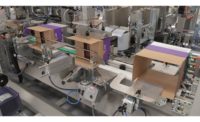Handle with Care
By Dan Malovany
When it comes to handling pans, sometimes the best sound is silence.
It used to be so loud in a bakery that operators almost couldn’t hear themselves think. In fact, many old timers spent their retirement years watching TV with the volume turned up all the way.
Certainly, earplugs are required by many companies to protect their employees’ hearing, but in the end, they’re a lousy way of improving communication on the plant floor.
As a result, equipment manufactures have been working to provide practical solutions for noise pollution, especially when it comes to the handling of pans and conveyors. Stewart Systems, for instance, has turned the volume down a bit by using plastic.
“The noise level in bakeries is high anyway, and everyone is trying to get the DB [decibel] level in their areas where people are to as low of a level as possible,” says Bob Urban, systems product manager for the Plano, Texas-based company. “Plastic belt conveyors don’t make any noise. You don’t even know that they are running. We’ve greatly reduced the noise in the bakeries as far as our equipment to almost nothing as far as conveyors go. It’s tough to tell they’re running because they are so quiet.
“If you can take the clank and bang and rattle out of the conveyor systems by going into plastic belts, you greatly reduce the DB load on the operators,” he adds.
Ken Mentch, vice president of sales for Oxford, Pa.-based Workhorse Auto-mation, adds that there are additional issues for bakers when it comes to pan stacking, unstacking and storage.
“Noise, gentle handling and extended pan life are all three important factors faced today, but added to these three classic concerns are two new concerns, floor space and labor requirements,” he says. “These two, floor space and labor, are becoming critical issue to all bakers.”
Actually, noise reduction and gentle handling are almost taken for granted today, says Charles Gales, manager, automation sales for Weldon Solutions, York, Pa.
“Now, the focus is on quick change-over, high production speeds, integrated communication with the plant and other equipment, labor reduction and safety such as eliminating ergonomic problems,” Gales says.
Who would have thought there were so many issues surrounding something as simple as pan handling?
Well, maybe it’s not that simple.
Robots, Changeovers and More
Over the years, continuous improvement in the use of electronics and other advances in technology have made pan handling more efficient and operator-friendly, Gales says.
“Robots are able to address these issues very well since they are programmable and can pick up different pan types without the need for changeover,” he explains.
Automatic storage and retrieval systems for stacked pans and troughs, he adds, can be networked together with other process equipment more so in the past. As a result, there is less operator involvement, and the systems are able to look ahead and make decisions based on the activity of upstream equipment, thus allowing for smoother changeovers.
Turning pans upside down for conveying stacking and storage offers several benefits, including improved sanitation, because debris either fall out of pans or can be cleaned easier because of gravity. Additionally, Gales says, stacking upside down can minimize pan damage.
That’s because the strength of a baking pan is in its rim. When a pan is stacked right-side-up, all of the weight is concentrated on the molds of the bottom pan, which can lead to damage or force a bakery to reduce the pan stack’s height to keep the weight at a manageable level. Stacking the pans upside-down transmits the weight to the rim, allowing pans to be stacked higher and saving on floor space, Gales notes. Weldon’s PanVertor stacks pans upside down, while its Universal PanVerter is capable of running bread and buns pans in any orientation with no changeover time required.
Using polypropylene or other durable plastic belting also can eliminate damage to pans. That’s why Stewart Systems uses them.
“The plastic belt also is a pretty easy fix when it breaks, and the wear and tear on pans is a whole lot less with plastic,” Urban says.
Additionally, he adds, using proximity sensors is better than photo sensors because they are not susceptible to flour dust, oil or grease, thus requiring less maintenance.
Meanwhile, Workhorse Automation’s pan stackers, unstackers and storage-and-retrieval systems have interlocked controls to allow operators to initiate a pan changeover from a remote location as a divider, Mentch says. Space saving also is a feature its systems provide.
“We have put a great deal of emphasis in our multilevel systems, specializing in the use of vertical space in bakeries allowing them to use their valuable floor space for more productive functions other than just storing stationary pans,” Mentch explains. “With our new controls architecture, the latest systems are a true on-demand system where the storage-and-retrieval system is actually proactive, analyzing the real time environment requirements rather than just being reactive.”
Moreover, he adds, the new systems take advantage of the latest laser position technology, which increases speed and accuracy. Workhorse Automation’s new interface menus also can assist in streamlining pan change-over, pan additions, maintenance, line start-up and system fault recovery.
Advances in laser technology has helped Weldon enhance its pan handling systems.
“We now use a laser in all axes of motion for our E300 automated pan storage system,” Gales says. “This provides direct non-contact measurement for the most accurate, closed-loop positioning possible. It eliminates previous positioning methods for the transfer vehicle unit that picks up pan stacks, which had relied on indirect measurement of a cable that moved with the transfer vehicle.
The cable was a maintenance factor that could fail if a person stepped on it or a pan fell on it. Using lasers to guide the pan transfer vehicle solves that problem.
“This change allows us to use the same device to position all axes of motion and eliminate a nuisance item for maintenance,” Gales adds.
For many companies, the ultimate goal is to help minimize downtime and make it easier to keep the plant up and running.
“We try to make [equipment] self monitoring so that when there are issues, it points a technician in the right direction and gets the problem solved and to get the system up and running again,” Urban says.
That’s music to a baker’s ears. SF&WB
Editor’s Note: For more information about these companies and equipment suppliers in general, visit www.snackandbakery.com and click on “Buyer’s Guide.” For more operations news, sign up on our Web site for SF&WB’s Operations Weekly.



